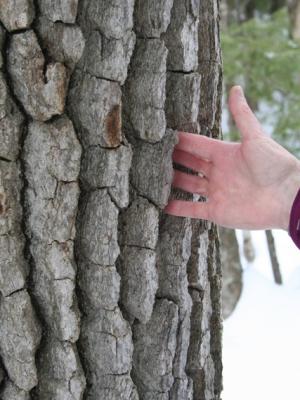Snowshoe sleuthing reveals value of conserving Pawtuckaway lakefront property
- Tags:
- Wildlife

Snowshoe hikers search for the creature that dropped its hemlock branch "leftovers" down onto the snow. The group was exploring the wildlife use of a 95-acre property on Pawtuckaway Lake that the Forest Society and Nottingham Conservation Commission are working to conserve. Forest Society photo.
Nottingham Conservation Commission member and expert wildlife tracker Kristen Lamb pointed out the tracks in the snow but didn’t give away their maker right away, giving the group behind her time to lean on their ski poles and look for more clues.

Hmmmm.
Most of us had made our guesses when Lamb noted that the trail meandered about, with no sign of hurrying. Then came the clincher hint:
“This is an animal that looks like it’s carrying 30,000 quills around on its back, and it’s not worried at all about predators.”
I had come up with porcupine, but 30,000 quills? Wow!
Besides working on her local conservation commission, Lamb is also executive director of The Center for Wildlife in Maine. Her background in wildlife ecology gives her plenty of experience for guiding wildlife tracking snowshoe hikes. Along with co-leaders Tom Howe and Martha Twombly, my colleagues at the Forest Society, Lamb was leading this hike to explore a beautiful, 95-acre property that will soon be conserved on Pawtuckaway Lake in Nottingham.
The forested property is right next to Pawtuckaway State Park. It’s private land, but through the generosity of the landowners, Helen and Rick Fernald, and the commitment of the town to conserving its special places, the land is close to being protected from development forever by what’s called a conservation easement. The Forest Society, with funds from the town plus those still being collected from donors, is buying – for far below market value, thanks to the conservation ethic of the landowner – an easement deed prohibiting development on this property. The easement will ensure that the land will remain intact while leaving ownership of it in the hands of the landowner. Future landowners will be able to manage it for agriculture and forestry or sell it, but they won’t be able to subdivide or develop it.
I wish everyone could experience a hike like this one, in this place. It might change the world. Thoughtless habitat destruction, pollution, littering and other forms of disrespect for nature would disappear like snowflakes landing on a kid’s tongue.
Even spending a couple of hours exploring the winter-quiet forest on this property is enough to deeply appreciate its ecological richness. We found evidence of at least 10 other wildlife species besides porcupines during our walk. We saw where a fisher, the porcupine’s main predator, followed a porcupine’s trail. (Quills actually dissolve under a fisher’s skin, Howe pointed out.) We saw the smooth channel where an otter slid across the snow and dropped into Mile Brook. We saw deer beds under sheltering hemlocks, snowshoe hare prints near a likely hare den and moose tracks surrounding a downed beech tree with its branch ends bitten off.

Once this land is conserved, it will become part of the largest contiguous block of conserved land in fast-growing southeastern New Hampshire. Lamb credits her community, strategic planning and education. “The more people we have understanding the way development can impact water quality and our quality of life – why we love Nottingham – the better we can do our job of conserving and protecting what’s here,” she said.
Because town funds are being used to buy the conservation easement, the Pawtuckaway land will remain open for people to explore, to fish, hike or just sit and admire black gum trees.
I suggest a snowshoe hike on a winter’s morning to see the forest come alive.
